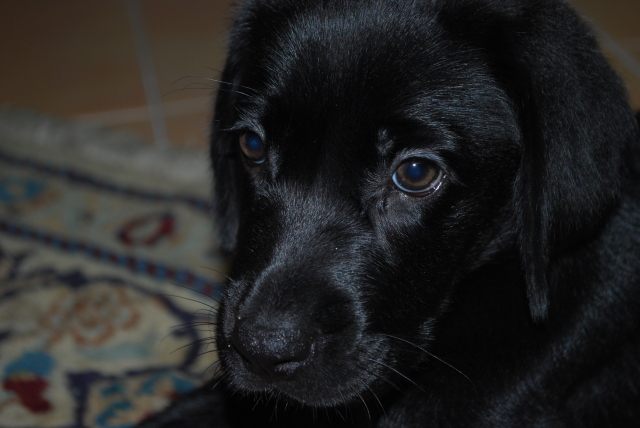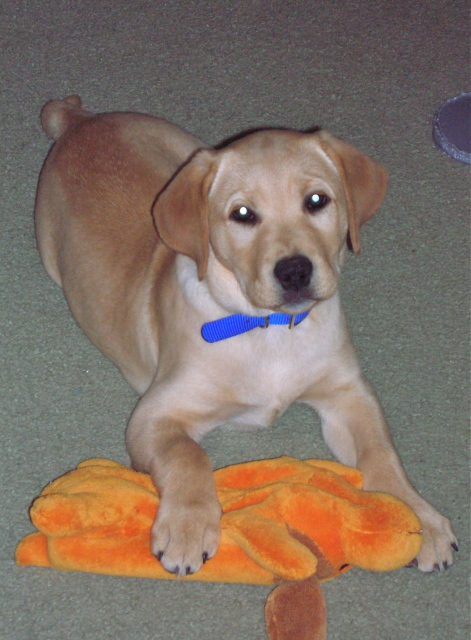QuestionHello. I am the owner of a 4-year-old, female, chocolate lab named Sophia. I adopted her when she was approximately 6 months old. She potty trained quickly, and all was fine until about 8 months ago. She abruptly began urinating in the house. She prefers the same area in the living room, about a 6 X 6 section of the carpet. We have taken the following actions in an attempt to correct the problem:
1) Took her to the vet for a physical. The doctor xrayed her kidneys, tested her urine for unusual sugar levels, and gave her a mid-year heart worm test. Fortunately, she was healthy. Unfortunatley, and 300 dollars later, the vet said she was probably just "rebelling" and offered few solutions.
2) We completely removed the carpet and pad from the effected area. We also painted the floor boards beneath the carpet. We purchased a piece of carpet to lay over the area (no pad, and the carpet is not anchored down, but simply draped on the floor like a rug). She is continuing to urinate and deposit fecal matter in the same area.
3) We both are gone most of the day (at least 8 hours most days), so we thought she might be lonely. We adopted a male, corgi mix, with whom Sophia quickly befriended. They play frequently, but she still continues to go to the bathroom in the house.
A few additional points for your review:
1) We have a large backyard, but no fence. She wears a harness and is attached to a tie-out when she goes outside. My parents and my husband's parents have large, fenced in yards, which Sophia visits often. She loves to play at her grandparent's homes, and never seems to have accidents at our home when she returns from a visit to grandma's house. I think it is directly related to the yard. Sophia will spend all day in my parent's backyard. I have to force her to come inside. At our home, she spends approximately 30 minutes outside, depsite the weather. My husband seems to think her behavior has to do with the fact that she has not been allowed to play at her grandparent's home that day, and, therefore, goes to the bathroom in the house in retaliation.
2)I am vigilant about letting Sophia outside when we are home. I let her out constantly in an attempt to avoid the problem, but she still seems to have accidents, even if I am home. Example #1: I let her out directly prior to bedtime (around 11pm). I wake-up at 5am, and let her outside first thing in the morning. Unfortunately, sometime between 11pm and 5am she has gone to the bathroom on the floor. This happens approximately 1-3 times per week.
Example #2- I often need to work quietly in my office, without being bothered by dogs. I let Sophia outside, bring her back in at her request (I never rush her: I always wait until she barks, as an indication she is ready to come in), and proceed to my office, shutting the door behind me. I exit the office not thirty minutes later to find urine and feces on the carpet (definitely Sophia's, by the way. I can tell the difference between the dog's waste, as the corgi is only 25lbs).
Bascially, Labman, I am at a total loss. I have spent hundreds of dollars in an attempt to solve this problem. I would like to get a fence, but my husband is hesitant, as he does not want to spend $3000 for fix that may not truly correct the problem. I am willing to try just about anything. I love Sophia very much, but her constant accidents are destroying my home, and causing a great deal of conflict between my husband and I, as he would happily take her to the pound without blinking an eye. Your assistance would be GREATLY appreciated. Thank you for your time.
Sincerely,
Andrea Malloy
AnswerI am siding with your vet. It is a little later than such problems usually come up, but dogs don't read what experts have to say and often fail to follow them. The key to most behavior problems is approaching things using the dog's natural instincts. Dogs see all the people and dogs in the household as a pack with each having their own rank in the pack and a top dog. Life is much easier if the 2 legged pack members outrank the 4 legged ones. You can learn to play the role of top dog by reading some books or going to a good obedience class. A good obedience class or book is about you being top dog, not about rewarding standard commands with a treat. Start at http://www.dogsbestfriend.com/ For more on being top dog, see http://www.dogbreedinfo.com./topdogrules.htm
You might also try a crate. It could make things worse with her fouling it. Other dogs may not be as bad as the young Labs I am plagued with. Still your house and dog
will be much safer with the dog in a crate when you are away. The dog may be
happier in its den than loose in the house. It relaxes, it feels safe in its
den. It rests, the body slows down reducing the need for water and relieving
its self. Dogs that have been crated all along do very well. Many of them
will rest in their crates even when the door is open. I think the plastic
ones give the dog more of a safe, enclosed den feeling. They are harder for
dogs to open too. Metal ones can be put in a corner or covered with
something the dog can't pull in and chew. Select a crate just big enough for the full grown dog to stretch out in.
Leave it some toys. Perhaps a Kong filled with peanut butter. Don't leave
anything in the crate the dog might chew up. It will do fine without even any
bedding. You will come home to a safe dog and a house you can enjoy.
Accidents and damaged possessions are the fault of whoever was watching the puppy. When you are watching it, immediately correct it as soon as it goes for anything except its own toys. In a quiet, but firm voice ''Bad dog, its name drop!''. Gently remove what ever and replace it with one of her toys, or if older, hold eye contact until the puppy drops it.
A dog that has not been crated since it was little, make take some work.
Start out just putting its toys and treats in the crate. Praise it for going
in. If you have been able to trust it with any bedding, put that in the crate.
Feed it in the crate. This is also an easy way to maintain order at feeding
time for more than one dog.
Use the crate only when you must I have a short length of chain fastened to
my computer desk. With more mats around the chair mat, this gives a place
where the puppy is with me, but about as controlled as in the crate, while
still allowing me to get some work done, or at least answer All Experts questions.

 Lab eating my house! (and everything else)
Question
Pepper
I have a sweet sweet black female lab t
Lab eating my house! (and everything else)
Question
Pepper
I have a sweet sweet black female lab t
 Eating Problems
Question
Datsun
I have a 9 month old,Black male Labrado
Eating Problems
Question
Datsun
I have a 9 month old,Black male Labrado
 Labrador behaviour
Question
Gordie
Name: Gordie
Age: 4 months
Sex: Male
N
Labrador behaviour
Question
Gordie
Name: Gordie
Age: 4 months
Sex: Male
N
 constant puppy barking
Question
My 13 week old female yellow lab barks consta
constant puppy barking
Question
My 13 week old female yellow lab barks consta
 the furious nature of my lab
Question
hero-male lab
he is a fawn coloured 3 and a ha
the furious nature of my lab
Question
hero-male lab
he is a fawn coloured 3 and a ha